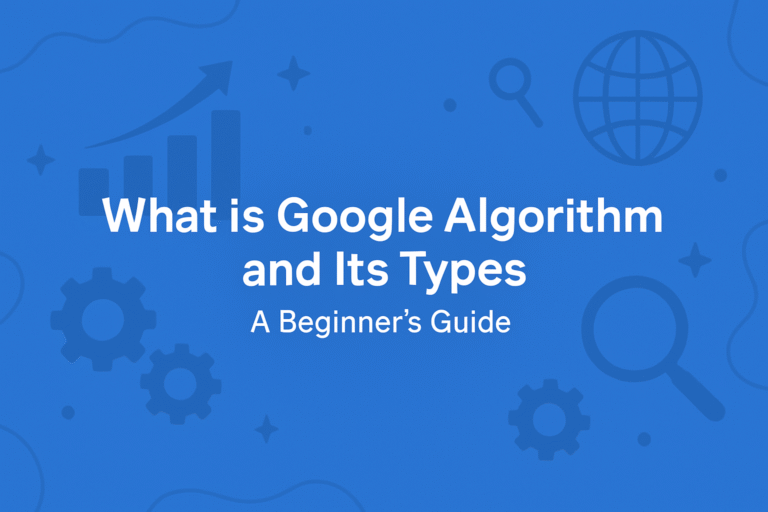
If you’ve ever wondered how Google decides which websites to show first in search results, the answer lies in its algorithm. To determine the best results for your query, it mixes hundreds of ingredients (ranking factors).
Table of Contents
What is a Google Algorithm?
A Google Algorithm is a complex system used by Google to retrieve data from its search index and instantly deliver the best possible results for a query.
Think of it like this: You ask Google a question. Google’s brain (algorithm) goes through billions of pages, picks the most relevant, useful, and trustworthy ones, and shows them in the top results.
What is Google Algorithm Used for in SEO?
SEO (Search Engine Optimization) is the process of improving your website so that Google ranks it higher. To do that, you need to understand how the algorithm works.
Here’s how Google Algorithms affect SEO:
- They decide which websites rank higher in search results.
- They penalize low-quality or spammy content.
- They reward fast, mobile-friendly, and relevant sites.
In short, the better you follow the algorithm rules, the higher your site appears on Google.
Types of Google Algorithms (With Examples)
Google uses multiple algorithms, and each has a special purpose. Let’s understand the main types with simple examples:
1. Panda Algorithm (Launched 2011)
The Panda Algorithm was one of Google’s first major steps toward improving the quality of search results. Before Panda, many websites with thin, duplicate, or poorly written content used to rank high in search results simply by stuffing keywords. This made it hard for users to find valuable and trustworthy information.
To fix this, Google introduced the Panda update, which specifically targets websites that:
- Have low-quality or shallow content (e.g., 100-word pages with no real value)
- Publish duplicate content copied from other websites
- Focus more on ads than actual content
- Contain keyword-stuffed or poorly written articles
- Create content farms (websites producing lots of low-effort articles)
🎯 Focus: Content Quality
Google Panda rewards websites that provide unique, informative, and user-friendly content. It ensures that users get to read pages that actually answer their queries, not just pages made for ranking.
💡 Tip for SEO:
- Always write original content, not copied or spun from other sites.
- Focus on giving value to the reader—helpful tips, how-to guides, examples, FAQs.
- Avoid clickbait titles that don’t deliver what they promise.
Make sure each page has a clear purpose and isn’t just created to fill space.
2. Penguin Algorithm (Launched 2012)
The Penguin Algorithm was Google’s answer to spammy link-building tactics that were used to artificially boost a website’s ranking. Before Penguin, many websites climbed to the top of Google just by building a large amount of backlinks, even if those links came from unrelated, low-quality, or fake websites.
With Penguin, Google started analyzing the quality, relevance, and naturalness of backlinks, not just the quantity.
🎯 Focus: Backlink Quality
Penguin targets websites that:
- Buy or exchange backlinks just to manipulate rankings
- Participate in link schemes or spammy directories
- Get links from irrelevant or low-quality websites
- Use over-optimized anchor text (e.g., using the same keyword repeatedly as the link text)
💡 Tip for SEO:
- Build organic, high-quality backlinks from trusted websites in your industry.
- Use varied and natural anchor text when linking.
- Avoid shady link-building services promising “1000 backlinks in 1 day.”
- Focus on earning links by publishing great content, guest posts, or research data.
3. Hummingbird Algorithm (Launched 2013)
Google’s Hummingbird Algorithm was a game-changer in how the search engine understands user intent, not just individual keywords. Before Hummingbird, Google’s algorithm focused more on exact keyword matches—so websites stuffed with keywords often ranked higher, even if they didn’t really help the user.
With Hummingbird, Google became much smarter at understanding the meaning behind the search, even if the exact keywords weren’t used on the page.
🎯 Focus: Understanding Search Intent & Context
Hummingbird helps Google:
- Understand the full query instead of just matching keywords
- Interpret conversational and question-based searches
- Deliver more accurate and meaningful results
It’s especially helpful with voice searches or longer, more complex queries.
💡 Tip for SEO:
- Write content that answers user questions clearly and completely
- Use natural language instead of just repeating keywords
- Focus on topics, not just keyword frequency
- Include FAQs and related phrases that show you’re covering the subject deeply
4. Pigeon Algorithm (Launched 2014)
The Pigeon Algorithm was designed to improve local search results—helping users find businesses and services near their physical location. Before Pigeon, local results were less accurate and often didn’t consider proximity or offline business data effectively.
With this update, Google connected its core search algorithm with local search, giving more importance to things like location, distance, reviews, and local citations.
🎯 Focus: Local SEO & Real-World Distance
Pigeon helps Google:
- Show results based on geographic location
- Prioritize businesses that have complete and accurate Google My Business (GMB) profiles
- Consider local directories, such as Yelp, Justdial, or Zomato
- Rank businesses with strong local presence and reviews higher
💡 Tip for SEO:
- Claim and optimize your Google My Business profile
- Add local keywords like city, area, or neighborhood names (e.g., “Bakery in Dwarka”)
- Encourage customers to leave positive reviews
- List your business on relevant local directories
- Use schema markup for local business (to help Google understand your location)
5.Mobile-Friendly Update(2015)
In today’s world, most people use their smartphones to search the web. Recognizing this trend, Google introduced the Mobile-Friendly Algorithm Update, often nicknamed “Mobilegeddon”, to ensure that websites optimized for mobile devices rank higher in mobile search results.
This update wasn’t about content—it was all about user experience on mobile devices.
🎯 Focus: Mobile Usability & Responsiveness
This algorithm checks if a website:
- Loads well on smartphones and tablets
- Has text that’s readable without zooming
- Ensures buttons and links are easy to tap
- Avoids using technologies that don’t work on mobile (like Flash)
- Adjusts the layout automatically for smaller screens (responsive design)
If your site isn’t mobile-friendly, Google may lower your rankings in mobile search results, even if your content is excellent.
💡 Tip for SEO:
- Use a responsive website design that adapts to any screen size
- Test your site with Google’s Mobile-Friendly Test Tool
- Improve loading speed on mobile (compress images, reduce scripts)
- Make sure your text is legible, and buttons are easy to click
- Avoid pop-ups that block the content on small screens
6.RankBrain Algorithm (2015)
RankBrain was a big leap forward for Google—it introduced Artificial Intelligence (AI) and machine learning into the search algorithm for the very first time.
Before RankBrain, Google relied on hand-coded rules to interpret search queries. But with more people using long, complex, or never-before-seen searches, Google needed a smarter system that could learn and improve over time.
That’s where RankBrain comes in.
🎯 Focus: AI + User Behavior + Relevance
RankBrain helps Google:
- Understand the meaning behind vague or unfamiliar queries
- Learn from user behavior (clicks, bounce rates, time spent on pages)
- Adjust search rankings based on what real users find useful
In short, RankBrain uses AI to interpret what you really mean when you search and measures how satisfied users are with the results.
💡 Tip for SEO:
- Focus on creating valuable content that answers user questions clearly
- Improve dwell time (how long users stay on your page)
- Reduce bounce rate (people leaving too quickly)
- Use natural, conversational language
- Think more about user intent than keyword stuffing.
7.BERT Update (2019)
BERT stands for Bidirectional Encoder Representations from Transformers — sounds super technical, right? Don’t worry. All you need to know is that BERT helps Google understand language better—just like a human would.
Before BERT, Google often misunderstood the context of words, especially in long or conversational searches. BERT changed that by allowing Google to look at all the words in a sentence together, not just one by one.
🎯 Focus: Understanding Context & Language Naturally
BERT allows Google to:
- Understand the true meaning of search queries, especially longer ones
- Grasp the context of words based on surrounding words
- Improve results for voice search and question-based searches
💡 Tip for SEO:
- Write in a natural, conversational tone
- Answer questions the way a human would, not like a robot
- Use complete sentences, headings, and bullet points for clarity
- Focus on clarity, structure, and purpose over just keyword usage
8. Mobile Usability & Core Web Vitals Update (2025)
Type: UX-focused
Focus: Speed, responsiveness, and visual stability — especially on mobile devices.
In 2025, Google refined how it evaluates user experience by further emphasizing Core Web Vitals — a set of key performance metrics that directly impact how users interact with your site. These vitals are now even more important in search rankings, especially as mobile-first indexing continues to dominate.
🔍 What Core Web Vitals Measure:
- LCP (Largest Contentful Paint): Measures loading performance. Ideally, your main content should load within 2.5 seconds.
- INP (Interaction to Next Paint): Replaces the older FID (First Input Delay) to better evaluate a user’s interaction experience — how quickly a website responds after a user taps or clicks.
- CLS (Cumulative Layout Shift): Measures visual stability. Pages shouldn’t shift around unexpectedly while loading.
These metrics help Google determine whether your website provides a smooth, fast, and user-friendly experience, particularly on smartphones and tablets — where most users now browse the web.
👉 Tip: Use tools like Google PageSpeed Insights, Lighthouse, or Web Vitals Extension to audit and improve:
- Mobile responsiveness
- Page loading times
- Unstable design elements
- Delayed user interactions
Improving your Core Web Vitals doesn’t just help with SEO, it also leads to higher user satisfaction, better engagement, and lower bounce rates
What is E-E-A-T in SEO?
E-E-A-T stands for Experience, Expertise, Authoritativeness, and Trustworthiness. It’s not a direct ranking factor, but it plays a big role in how Google evaluates your content—especially for topics that affect people’s health, money, or safety (also called YMYL – Your Money or Your Life topics).
Let’s break it down:
- Experience: Shows that the content creator has personally used or dealt with the topic.
Example: A skincare blogger sharing their real results using a product. - Expertise: Refers to the knowledge or skill of the writer.
Example: A certified doctor writing health-related articles. - Authoritativeness: Means the site or author is well-known or respected in their field.
Example: A popular finance website like Investopedia. - Trustworthiness: Your website should look safe, honest, and reliable.
Example: Secure HTTPS site, accurate info, clear contact details.
SEO Tip: To improve E-E-A-T, focus on publishing helpful, accurate content written by people who truly understand the topic. Also, show author bios, use secure connections (HTTPS), and earn good reviews and backlinks.
Understanding Google’s algorithm updates helps you stay ahead in SEO and keep your website ranking strong. From content quality to mobile usability, every small improvement adds up. Keep learning, keep updating your site, and always focus on giving users the best experience. 🚀
